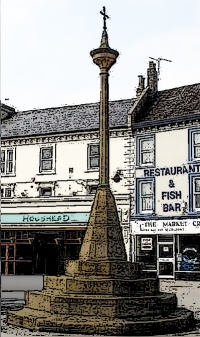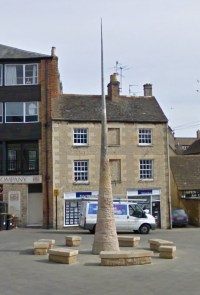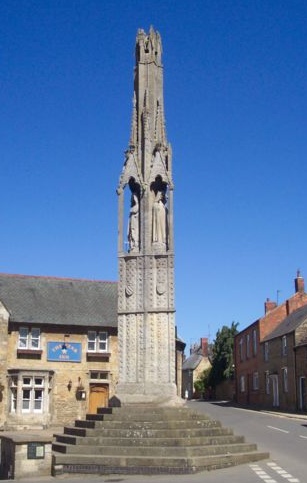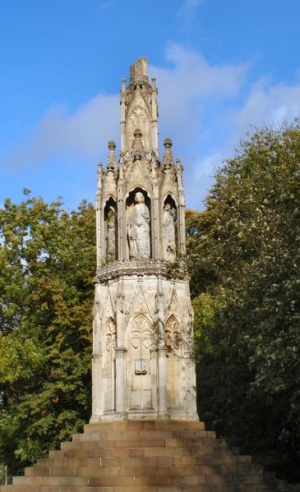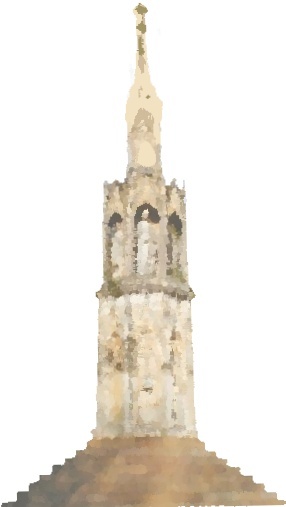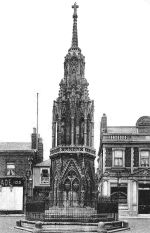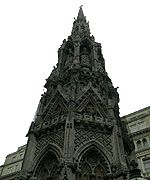Eleanor Crosses
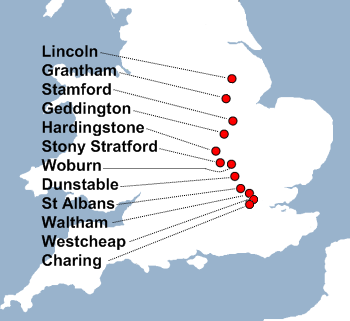
Route of Queen Eleanor's cortege
For this particular beloved person, twelve memorial crosses were erected.
On 1 November 1254, the future king of England, Edward I, married Eleanor of Castile, Spain, and they were devoted to one another. She bore 17 children, including Joan of Arce (not Joan of Arc) and Edward II.
She accompanied her husband on military campaigns and two years before their coronation, while fighting in the Crusades in Palestine, he was stabbed by a poisoned dagger in his arm. There is a legend that she saved his life by sucking the poison from that wound.
Eleanor died on 28 November 1290 at the manor house of Richard de Weston near Lincoln, about 200 kilometres north of London.
Edward took her body to Westminster Abbey in London for a state funeral service. It took several days for the cortege to complete its journey from Lincoln and over the next few years, an Eleanor Cross was erected as a memorial at each of the twelve overnight stopovers. As seen on the map, the distances twixt the overnight stops shortened as no doubt the cortege tired.
The Eleanor Crosses varied in design and size since they were erected by different artisans, and the crosses nearly always bear the name of the locality in which they were erected. It can be imagined at that time, one village looked pretty much like the next, being all situated on old Roman roads (Ermine Street and Watling Street). Although spaced within a short distance, it is interesting to see how diverse the twelve places have become since 1290.
Lincoln
A small stub of the original St. Catherine's Cross is in the museum of Lincoln Castle; an 11th century fortress built by William the Conqueror. The castle also houses one of the original copies of the Magna Carta, and for a time was a grim holding prison for convicts destined for Australia, Gibraltar and Bermuda. The castle is also near the site of the ancient St. Catherine's Priory, where Eleanor's body was embalmed.
Grantham
No part of the original Grantham Cross has survived, although there's a more recent Market Cross (shown left) in Market Place. The town is relatively small and just five miles to the east is Woolsthorpe Manor, where Isaac Newton laid the groundwork for classical mechanics after seeing an apple fall to the ground.
Grantham produced the world's first diesel engines, developed caterpillar track technology, opened the world's first public library, recruited Britain's first female police officers, and gave the country its first female Prime Minister, Margaret Thatcher.
Stamford
A small piece of marble from the original Eleanor Cross in Stamford can be seen in the town's museum. The town is built in fine quality stone and home to the discovery of one of the most complete dinosaur skeletons found in Britain, fifteen metres long. Coincidentally, many of the Eleanor Crosses were constructed with Purbeck marble which was formed in the Jurassic period, about 140 million years ago.
A new Stamford Cross (see photo) was erected in 2008
Geddington
The Geddington Cross is the most complete and best preserved Eleanor Cross. The plinth is unusual in that it has a triangular cross-section. Geddington is also unusual in that it owns the only known crime sheet in the world for Queen Eleanor!
Hardingstone
The Northampton Cross is still standing in the village of Hardingstone at the edge of the Benedictine Delapré Abbey. This was a simple convent and so Edward was accommodated at nearby Northampton Castle.
Stony Stratford
Until its destruction in the Civil War in the 17th century, the Stony Stratford Cross stood somewhere near the stony ford where Watling Street met the river Ouse.
We don't know what the cross looked like; no drawings remain and each of the twelve Eleanor Crosses was designed by different artisans.
Woburn
Nothing now remains of the Woburn Cross and its location, somewhere to the east of Watling Street, is only a vague guess. The village of Woburn can be traced back to Saxon times; 'wo' meaning twisted or winding and 'burn' a small stream, yet no significant stream or river is visible in the vicinity today.
The funeral procession stopped for the night at a Cistercian abbey founded by Hugh de Bolebec in 1145. The abbey was dissolved in 1539 and its location is uncertain, although legend has it that the current Woburn Abbey, constructed in 1746, was built around the former abbey's cloister.
Dunstable
The cortege then continued on to the neighbouring Augustinian Priory at Dunstable in Bedfordshire. The body of queen Eleanor was laid before the high altar of St. Peter's Church for the night. The following morning, after a requiem, the procession continued on to St Albans. Shortly afterwards, a monument was erected in Dunstable and stood for 350 years before being demolished in the Civil War in 1643
The present Dunstable Cross (see photo) dates from 1985.
St Albans
Third century St. Alban was the first Christian martyr in Britain. In the 8th century, on the hill where he was believed to have been decapitated, a Benedictine abbey was founded and named after St. Alban. In the 13th century, it was here that the Eleanor Cross was erected.
The cross disappeared with the abbey when it was dissolved in 1539. The huge St Albans Cathedral stands on the same site today.
Waltham
One of the three surviving medieval Eleanor Crosses is in the Hertfordshire town of Waltham Cross. The original statues of Eleanor within that structure were relocated in the 1980s to protect them from air pollution. The cross appeared taller when it was first built but over the years, the seven or eight steps leading up to the cross have been covered by successive road surfaces. Now only the top step can be seen.
Cheape
A bizarre history of a monument that suffered in the hands of rioters and rebuilders over the 350 years of its life. Eventually, under an ordinance from the parliamentary Committee for the Demolition of Monuments of Superstition and Idolatry "the cross in Cheapside was pulled down. At the fall of the top cross, drums beat, trumpets blew, and multitudes of caps were thrown in the air, and a great shout of the people with joy." said Sir Robert Harley, sent by Parliament to pull down the monument.
Charing
There is now a 70ft high 1863 replica of Eleanor's Cross just outside the station at Charing Cross, about ½ mile from the Abbey. 'Charing' is derived from the Anglo-Saxon cearring, which means 'a bend in the river'.
There's another, more romantic notion: 'My dear queen' in French is Chère Reine, which might have evolved into Charing over time.

